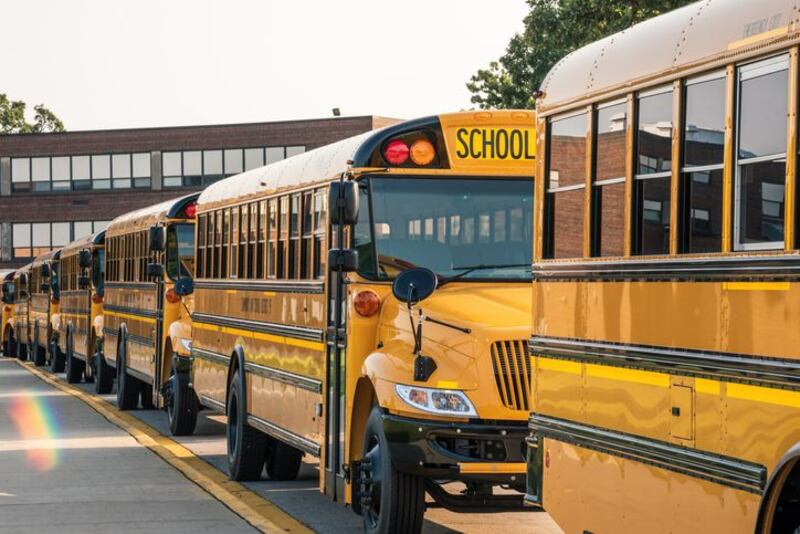DAYTON — There’s no debate that everyone wants children to be safe on their way to school. But there are huge arguments over whether seatbelts are the best, most cost-effective method to do that.
The I-Team’s Mike Campbell went looking for answers at the world’s leading bus crash testing facility called the Immi Company in Indianapolis.
The company believes seat belts make a huge difference in student safety during crashes and should be mandatory. They test daily and warn that even using their crash test dummies can upset those who watch the video.
The engineers at the Immi Company spend three weeks putting all the cameras and sensors on buses to gather information about what happens during crashes. Then, they deliberately crash the buses into a barrier wall.
Melissa Dobbs has spent 24 years working at Immi and their Center for Advanced Product Evaluation or CAPE. She said, “It’s absolutely important. It’s our kids we’re talking about.”
Dobbs admits the sights and sounds of the wrecks are chilling. Even worse, is what happens to the dummies inside the bus. Current federal law calls for compartmentalization of children on board, meaning high seatbacks for protection.
“It’s effective in a head-on crash when the child is in a seated position,” Dobbs said. “It’s a very violent form of safety, deforms the seat, potentially breaking a nose and potentially a concussion.”
Dobbs said the images are much different when the fake children on the bus are in three-point seat belts. They are jerked around but stay in their seat and avoid head and face injuries.
The differences are even more dramatic when Immi tests rollover crashes.
According to Dobbs, they test using their in-house simulator and do rollovers with real buses in outside settings. The unbelted crash test dummies are violently thrown into other students across the aisles and face-first into the roof. You compare that to the tests with subjects wearing belts.
“They stay where they are supposed to stay. They stay away from the roof, and they stay away from other kids they could be interacting with,” Dobbs said.
Every enclosed vehicle on the road in Ohio requires the people on board to wear a seat belt, except for buses. This debate is hot in Ohio because of what happened in Clark County last August. A driver crossed the center line and hit a Northwestern School bus, forcing the bus to roll onto its side.
Aiden Clark, 11, was ejected and killed in that crash. Authorities said 21 of the other 51 students on board suffered injuries.
Brittany Fischer is a mother and had two sons on that bus. “When I rolled up to the scene, I broke down because I thought the worst.”
Fischer has been advocating for seat belts on buses for the last nine months. Ohio Gov. Mike DeWine created a school bus safety task force to look at the issue. The group ended its work by recommending seat belts but not making them mandatory.
News Center 7 asked Dobbs “What goes through your mind?” She said, “We’ve seen a lot around the country, so it’s disappointing, but not surprising.”
If school districts and lawmakers are concerned bout paying for a seat belt upgrade, Dobbs said, “Cost shouldn’t be a factor for modern buses with a lifespan of about 15 years.”
“So, over the life of a school bus, seat belts cost about $5,000 per kid, per year. So, it’s not a dramatic undertaking,” Dobbs said.
She continued by saying seat belts only add $7,000 to $10,000 to the price tag of a new bus, which averages $115,000 and the governor seems to want the state to help.
“We shouldn’t have schools in a situation where they buy a bus and they say ‘Well, we can’t afford the extra $10,000 or $15,000 at a cost to do A, B, C,’” DeWine said.
So far, there is no official state-sponsored grant fund set up for school districts to draw from. Dobbs said her company can even retrofit existing buses with seat belts for $3,500 per vehicle.
She doesn’t believe any parent would say no to $5,000 per year, she’s just working to convince everyone else involved to say yes to seat belts.
“There’s absolutely no reason we shouldn’t be moving in this direction,” Dobbs said.
One state representative introduced a bill to make seat belts mandatory on Ohio school buses about a week after the crash in Clark County. That proposed legislation has not yet gained any traction.
©2024 Cox Media Group






